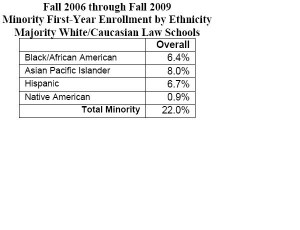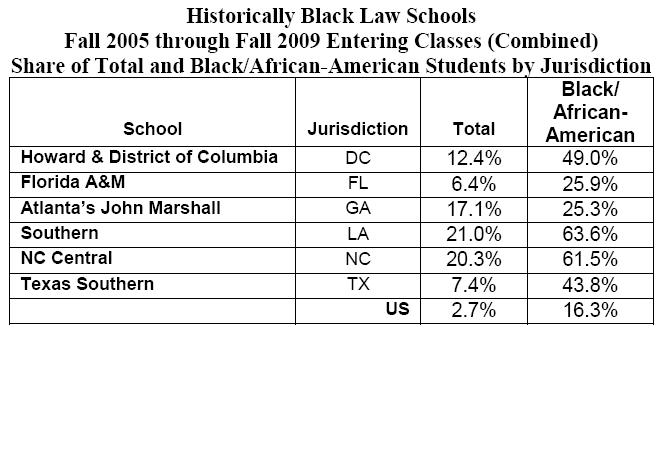Despite the Supreme Court’s decision in Grutter v. Bollinger, 539 U.S. 306 (2003), historically Black law schools (HBLS) still plays an important role in the education Black/African American law schools. According to the ABA’s statistics, the proportion of entering law students who were Black/African American peaked in 1998, at 8.1%, and then fell to 6.5% in 2005. Since then, that proportion increased to 7.3% in 2009. Because those statistics includes students enrolled in historically Black law schools, it does not show the level of minority enrollment in law schools in which a majority of the students are White/Caucasian–the bulk of law schools. As shown in Table 1, for the Fall 2006 through Fall 2009 entering classes, Black/African-American enrollment in majority White/Caucasian law schools has average 6.4%, lower than the shares of both Asian/Pacific Islander, and Hispanic, entering students:
Arguably, seven ABA-accredited law schools are historically Black law schools: Howard University and the University of the District of Columbia (DC); Florida A&M (FL); Atlanta’s John Marshall (GA), Southern University (LA), North Carolina Central University (NC), and Texas Southern University (TX). As shown in Table 2, these seven schools are vital to the opportunity of Black/African-American students to enroll in law school.
If the ABA is serious about increasing the diversity of the legal profession, especially for Black/African Americans, it needs the historically Black law schools. ABA accreditation, and Bar passage concerns has already adversely affected Black/African American enrollment in these schools. Raising the minimum Bar passage rate requirements would only accelerate that trend. But more on that later.
Posted by Gary Rosin


Howard University School of Law is ranked in the third tier of the US News annual rankings